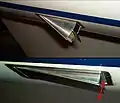Bailing (boats)
Bailing is the process of removing water from a vessel.
Hand bailers
A hand bailer is a device used for manually removing water which has entered a vessel. In the simplest case, it is merely a smaller container which can be filled and then emptied. This kind of device has been in use since early times. It is still in use on small boats and rafts, though some are self-bailing. Some regulations require either or both forms of bailing.[1][2]
 Iron Age hand bailer from Nydam Mose
Iron Age hand bailer from Nydam Mose Norwegian "auskjer", traditional hand bailer
Norwegian "auskjer", traditional hand bailer modern plastic hand bailer
modern plastic hand bailer
Self bailers
For some modern types of dinghys in sailing sports hand bailers can be obsolete when they are equipped with self bailers, sometimes also called automatic bailers. Self-bailing boats are shaped so that they will drain completely if filled with water; powered by the venturi effect and the motion of the boat, they are distinct from the powered bilge pumps used on non-self-bailing boats.
 Self bailer, rear type
Self bailer, rear type Self bailer, bottom type outside the boat
Self bailer, bottom type outside the boat Self bailer, bottom type inside the boat
Self bailer, bottom type inside the boat Plans for a 1911 self-bailing lifeboat. Note that the deck is higher than the waterline, so that it can drain.
Plans for a 1911 self-bailing lifeboat. Note that the deck is higher than the waterline, so that it can drain.
References
- ISO 9650 Small craft, inflatable liferafts 2005(E) (pdf-file 244 KB) Archived 15 September 2012 at the Wayback Machine
- ISAF (International Sailing Federation), liferafts